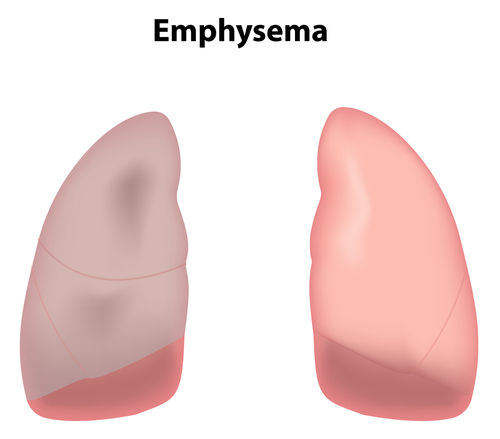 Emphysema refers to an abnormal permanent enlargement of the distal airspaces and the terminal bronchioles, along with the destruction (loss of elasticity) of alveolar walls and the supporting structures feeding the alveoli. This occurs mostly as a result of the elastase and proteases which cause hydrolysis of elastin protein of the alveolar sacs and terminal bronchioles, reducing their capacity to inhale and exhale air and reducing the overall surface area for gas exchange.
Emphysema refers to an abnormal permanent enlargement of the distal airspaces and the terminal bronchioles, along with the destruction (loss of elasticity) of alveolar walls and the supporting structures feeding the alveoli. This occurs mostly as a result of the elastase and proteases which cause hydrolysis of elastin protein of the alveolar sacs and terminal bronchioles, reducing their capacity to inhale and exhale air and reducing the overall surface area for gas exchange.
There are three pathways that lead to emphysema affecting the alveoli:
- Centriacinar emphysema, which affects the respiratory bronchioles of the upper lobe of the lungs. This is most common with cigarette smoking.
- Panacinar emphysema where the alveoli distal to the terminal bronchioles in the lower lobes get affected. This is mostly common in people with AAT deficiency.
- Distal acinar emphysema which affects the distal (paraseptal) alveolar ducts and alveolar sacs. Formation of apical bullae is common in this case. This can cause severe compression on the adjacent lung tissues as well.

WE ARE LOOKING FOR INFORMATION ABOUT STEM CELL TRIAL FOR
EMPHYSEMA. THE PATIENT HAD ROBOTIC SURGERY APRIL 2016 AND RECENT SCAN CLEAR. HOWEVER, HER EMPHYSEMA SHOWED AN INCREASE. IF YOU HAVE ANY INFORMATION THAT CAN HELP PLEASE
I have trapped air in my lungs . I’ve been diagnosed with bronchitis . Fluid build up in lungs.